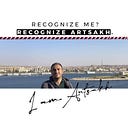Artsakh is Armenia 🇦🇲
Artsakh is -a word made up of two parts, the first is Ara, the sun god, according to the ancient Armenians, and the second word means forest or vine, so the Armenian name means a forest or vine of the god Ara- is an integral part of historic Armenia. During the Urartian era (9-6th cc. B.C.) Artsakh was known as Urtekhe-Urtekhini. As a part of Armenia Artsakh is mentioned in the works of Strabo, Pliny the Elder, Claudius Ptolemy, Plutarch, Dio Cassius, and other ancient authors.
On June 2, 1992, the breakaway Republic of Artsakh -an independent republic, in the South Caucasus region-, adopted a flag derived from the flag of Armenia, -The national flag of Armenia was used in the Nagorno-Karabakh Republic until 1992- to which a white, five-toothed, stepped pattern is added, beginning at the two verges of the flag's fly and meeting at a point equal to one-third of the distance from that side.
Colors connotation
The white pattern represents the mountains of Armenian Artsakh, and additionally forms an arrow pointing westward to symbolize the aspiration for eventual union with Armenia. This symbolizes the Armenian heritage, culture, and population of the area, and the triangular shape and zigzag cut represent Artsakh as a separated region of Armenia. The white pattern on the flag is also similar to the designs used on rugs, a symbol of national identity. The ratio of the flag's breadth to its length is 1:2, the same as the Armenian Tricolor.
Coat of arms of the Republic of Artsakh
The emblem of the Republic of Artsakh consists of an eagle above which is an ornamented crown. On the chest of the eagle is a shield with a panorama of a mountain range and under it a vertically set Flag of Artsakh. Over this are the two stone heads of "Granny and Gramps" (Tatik yev Papik) from the We Are Our Mountains monument in Stepanakert, the capital of Artsakh. The eagle's feet clutch various agricultural products including wheat and grapes. The outer rim is made up of a golden circular ribbon bearing the inscription "Artsakh Republic of Mountainous Karabakh".
We Are Our Mountains monument
monument north of Stepanakert, the capital city of the Republic of Artsakh. The sculpture, completed in 1967 by Sargis Baghdasaryan, is widely regarded as a symbol of the Armenian heritage of Nagorno-Karabakh. The monument is made from volcanic tufa, and represents the busts of two peasants with stylized faces, a bearded man and a woman, with traditional headdresses reminiscent of two summits of Ararat. They materialize "the indomitable local spirit". The woman’s mouth is hidden by a scarf, according to local tradition, and the two busts seem to be leaning against each other’s shoulders. The faces are placed directly on the ground: the sculpture is not erected on a pedestal. Made in 1967, the sculpture is the work of the Armenian sculptor Sarkis Baghdassarian. It is located on a hillock, near the road, 1 km northeast of Stepanakert. When Soviet representatives from Baku came to Stepanakert for the inauguration in 1968, they asked, "Don’t these figures have legs?" The artist replied, "Yes, and they are deeply rooted in their land.". It is also known as "tatik-papik" (տատիկ-պապիկ) in Armenian, which translates as "Grandmother and Grandfather".
#Artsakh #Armenia #RecognizeArtsakh #NagornoKarabaj #Karabakh #Stopazeriterrorism
#Azerbaijan #Azerbaïdjan #armenianbreakingnews
#ArtsakhStrong
